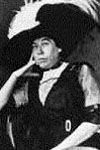
|
|
Titanic History Tuesday, December 2, 2025 |
| 1889 - 3rd class passenger Mr Edvard A. Larsson-Rondberg was born to Lars Persson (farmer) and Maria Nilsdotter in Ransbysäter, Lysvik, Värmland, Sweden.
1890 - 3rd class passenger Mr Johannes Halvorsen Kalvik was born to Halvard Gotskalkson Halleland and Severine Nilsdotter Kalvik. 1872 - 3rd class survivor Mr Franz Karun was born to Janez Karun and Marija Treljec in Austria-Hungary (now Slovenia). |
| Shop at Cafepress |
 |
 |
| more Titanic designs |

People: First Class: Mrs. James Joseph Brown
(Margaret "Maggie" Tobin)
Maggie spent her childhood in Hannibal growing up just a few blocks from the Mississippi River. She attended her aunt's grammar school and spent her teenage years stripping tobacco leaves at Garth's Tobacco Company. When Maggie turned eighteen she followed her brother Daniel and her sister Mary Ann and Mary Ann's new husband Jack Landrigan to Leadville, Colorado. There she shared a small cottage with her brother Daniel while working for Daniels and Fisher Mercantile working in the Carpets and Draperies Department. During the summer of 1886 Maggie met James Joseph ("J.J.") Brown, whom was a miner with irish immigrant parents like herself. After a short courtship, they were married on September 1, 1886 in the Annunciation Church in Leadville. After their marriage Maggie moved into J.J.'s cabin in Stumpftown. There they had two children, Lawrence Palmer and Catherine "Helen" Ellen. They eventually moved back to Leadville to be closer to their family. In the early 90's Maggie got involoved in the early feminist movement in Leadville. She also had a hand in the establishment of the Colorado Chapter of the National American Women's Suffrage Association. Maggie also worked in soup kitchens to assist families of Leadville miners. When the Sherman Silver Act was repealed in 1893, Leadville was thrust into a deep depression and the unemployment rate was 90 percent. J.J. Brown, had an idea. Convinced that the Little Jonny Mine he worked for might become a producer of gold rather than silver. He devised a plan to reach the gold at the lower depths of the mine. By October 29, 1893, the Little Jonny Mine was shipping 135 tons of ore per day, and Brown was awarded 12,500 shares of stock and a seat on the board. Over the years he became one of the most successful mining men in the country. On April 6, 1894 the Brown's bought a home on Pennsylvania Street in Denver and also a summer home in the foothills. After their move to Denver Maggie became very active in Denver's Women's Club, which she was a founder of. She also ran for the Senate eight years in a row - before women even had the right to vote. Maggie was on a trip with her daughter Helen when she received word that her grandson, Lawrence Palmer Brown, jr. was ill. She was staying with J.J. Aster and his new wife Madeline in Cairo, Egypt and knew of their return passage on the Titanic. She quickly booked a trip on the Titanic from Cherboug, France. At the last minute her daughter decided to stay behind in London. Due to Maggie's hasty departure from Europe, none of her family knew that she was unboard the Titanic when it sank. After the Titanic struck the iceberg Maggie was forced to board lifeboat 6 with Quartermaster Hitchens manning the boat. To keep spirits up and to keep warm Maggie pursuaded the women to help row the boat. After boarding the Carpathia, Maggie helped console the survivors whom had lost so much when the ship sank beneath them. Upon their arrival in New York Maggie helped set up the Survivor's Committee and raised over $10,000 for the survivors. In addition Maggie was present to help dedicate the memorial in Washington D.C. and also placed wreaths on the graves in Halifax. Throughout the rest of her life she continued to help the survivors of the Titanic however she could. Maggie died on October 17, 1932 of a brain tumor in New York. After her death she became a sort of a ledgend with many stories about her life that never occured. A play was wrote after her titled "The Unsinkable Molly Brown" which she would be referred to as such in history. |

Historical Info
timeline
life onboard
people
sinking
aftermath
People
passenger list
1st class
list
biographies
2nd class
list
biographies
3rd class
list
Crew
biographies
musicians
life onboard
people
sinking
aftermath
People
passenger list
1st class
list
biographies
2nd class
list
biographies
3rd class
list
Crew
biographies
musicians
get this countdown
for your website
for your website
random quote:
about back-to-titanic.com | contact us
